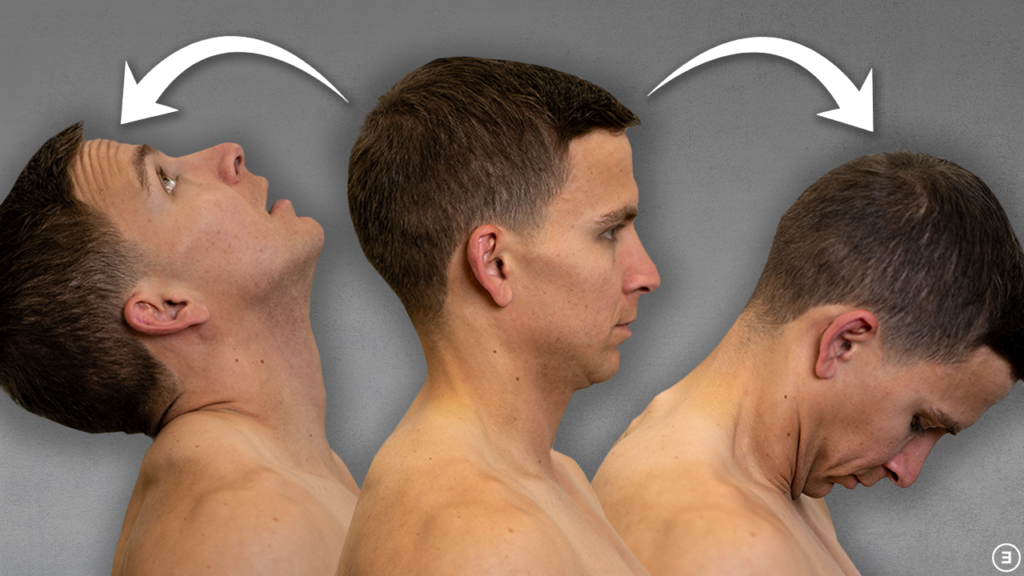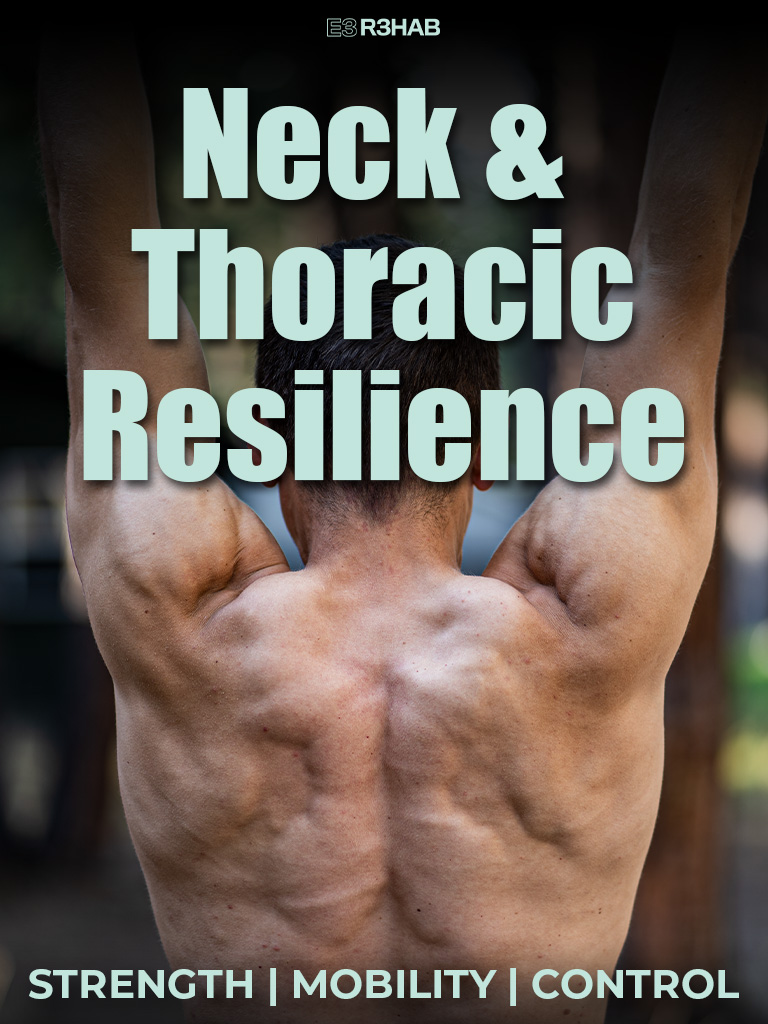The purpose of this blog is tell you everything you need to know about whiplash injuries AND provide you with a comprehensive rehab program!
Do you have new, lingering, or recurring neck or thoracic symptoms that’s stopping you from doing the things you enjoy or keeping you from feeling like yourself? Check out our Neck & Thoracic Resilience Program!
Whiplash Injuries
Whiplash injuries result from the rapid acceleration and deceleration of the head and neck, usually during a motor vehicle accident. Whiplash-associated disorders (WAD) refer to the various symptoms people experience after a whiplash injury, with neck pain being the most common. Other symptoms include dizziness, headaches, unsteadiness, and fatigue. There are also known similarities between whiplash-associated disorders and concussions, such as attentional and memory issues.
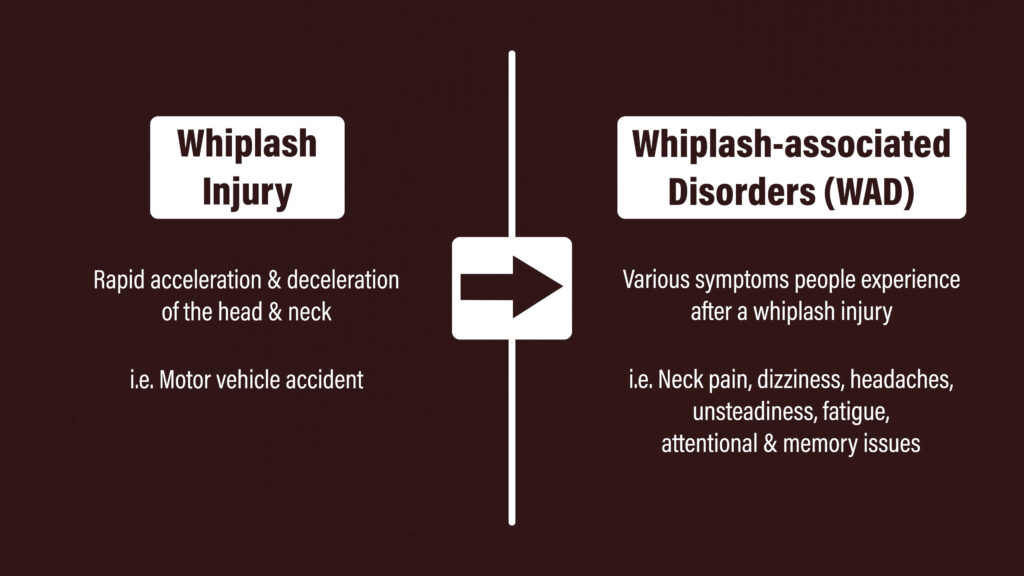
Whiplash Injuries Can Be Life Changing
For some individuals, whiplash injuries are life-changing. Qualitative studies by Ravn et al and Juuso et al in 2020 interviewed people living with chronic whiplash-associated disorders to explore their experiences and perspectives.
One participant stated, “I’m not the same as I was before – neither mentally nor physically.”

Other participants described difficulties with sleep, exhaustion from hypervigilance, constant anxiety, guilt, fearfulness, and a host of other feelings and emotions.

Some people reported feeling lonely, misunderstood, and even invisible:
- “The X-rays don’t show anything, and that’s a bit sad, I think, because then it’s even harder for others, and for employers, to understand why you have the limitations that you have.”
- “Also, the fact that it’s invisible. It’s very, very difficult, when others can’t see it on you that you’ve been in an accident.”
Individuals also reported feeling judged and ridiculed:
- “It’s a struggle all the time … to prove that you feel ill. It’s hard to be accepted by others; they’re so judgmental.”
- “I actually feel that I am a clown. I put on a mask. I spend a lot of energy on being something that I am really not.”

Why Don’t Demolition Derby Drivers Develop Chronic Neck Pain?
But if whiplash injuries can be so debilitating, why don’t most demolition derby drivers develop chronic neck pain?

Are they better prepared and braced for impact?
Are their expectations different?
Do they experience less trauma? Here are 2 more quotes from the Ravn paper:
- “They were enormously aggressive, those I hit. They were simply so aggressive! So I felt very, like, attacked.”
- “I have had nightmares about being in the hospital and not getting help.”
Do demolition derby drivers not have to deal with the added stressors of guilt, blame, or legal issues?
A prospective study by Sterling el al in 2010 found that “there is an overall detrimental effect associated with lodging a compensation claim on both physical and psychological outcomes following whiplash injury.”
I don’t have a definitive answer, but I wanted to highlight the complexity of whiplash injuries. This information will also be useful for understanding how to best approach the rehab process.
Goals of Rehab
Among the individuals who develop persistent symptoms and chronic disability, there are some commonalities that are important to mention for the purpose of this blog:
- Lower self-efficacy, which relates to the belief in ability to accomplish a task or achieve a goal
- Negative expectations of recovery
- Passive coping, which is characterized by helplessness and reliance on others
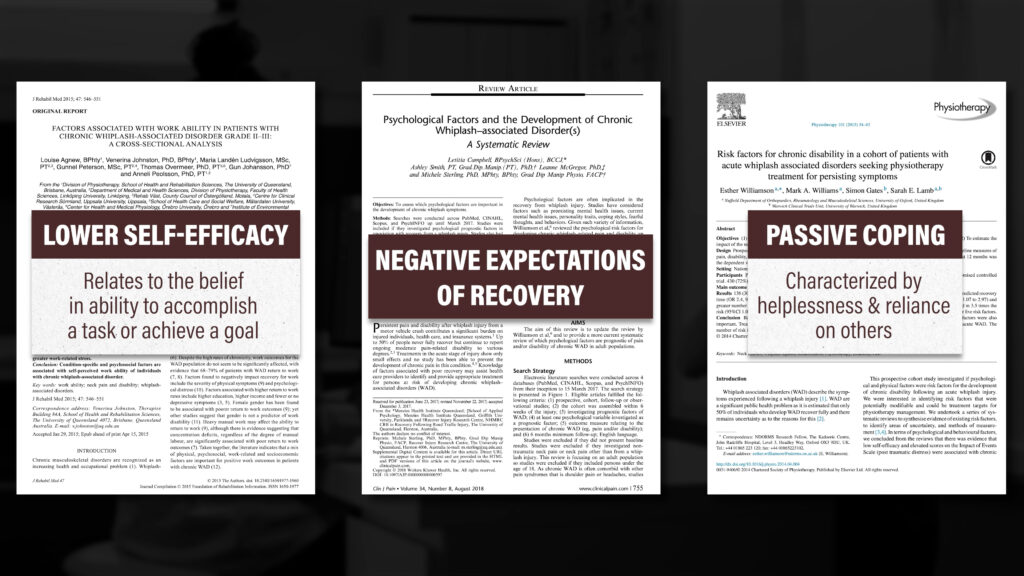
Based on this research and another qualitative study by Griffin et al in 2021, it may be beneficial to try to accept your current situation, shift to a more positive mindset, and focus on active coping strategies.

Obviously this is much easier said than done, but I think recognizing and attempting to better understand your situation is half the battle.
To keep things simple, the purpose of rehab is to improve 3 things:
- Confidence, so that you feel more in control of your situation and less fearful that you’re harming yourself when experiencing pain. Your sensitivity might be increased for a variety of reasons, but it is safe and encouraged to move and exercise after a whiplash injury.
- Function, so that you have the strength, endurance, and range of motion to perform the activities you need to do or want to do.
- Tolerance, so that you can do more over time despite symptoms.
The exercises I’m going to present may help with headaches, dizziness, and other related symptoms, but, as I just mentioned, the primary purpose of this blog is to improve your overall confidence, function, and tolerance. And due to the complexity of whiplash injuries, it is important to consult with a medical doctor or other healthcare professionals prior to beginning a new exercise program.
Range of Motion Exercises
The first category of exercises addresses any limitations in your rotation range of motion.
Option 1: Side Lying Rotation – Lie on your side with your hips and knees bent, and head supported. Rotate your top shoulder and arm toward the floor behind you, or as far as you can comfortably go.
Option 2: Seated Rotation – With your arms out in front of you, reach one hand toward the wall behind you, return to the starting position, and then repeat on the other side.
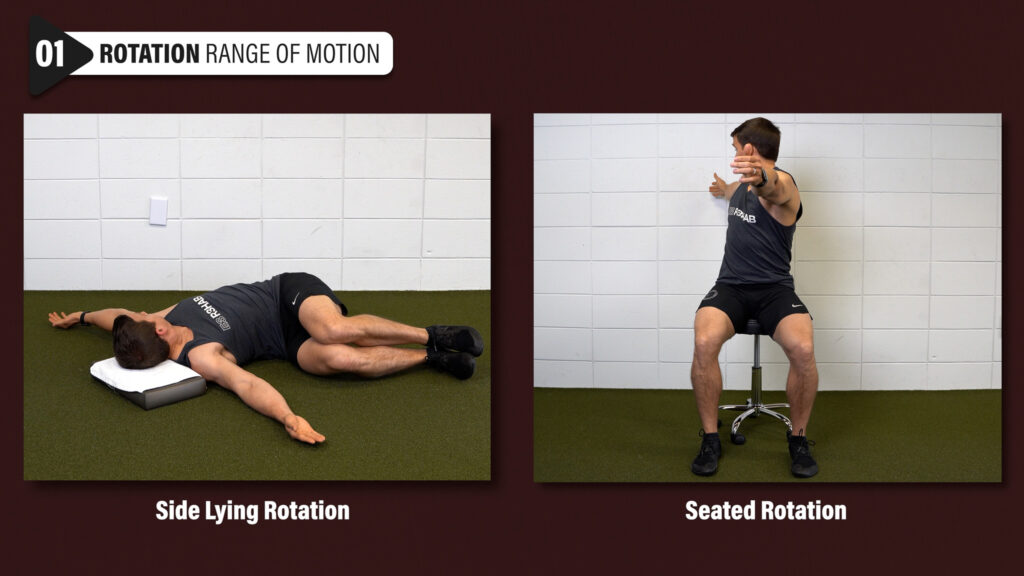
You can also lean forward, grab the opposite knee, and reach up toward the ceiling.
Determine which option feels better for you and perform it as needed for 6-8 slow and controlled repetitions per side.
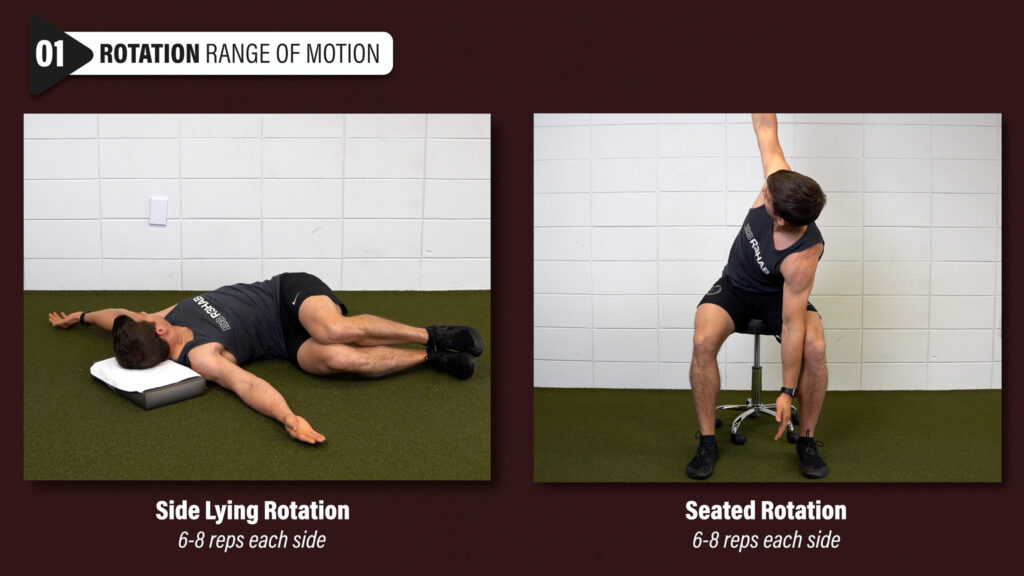
The second category of exercises addresses any limitations in your flexion and extension range of motion.
Option 1: Quadruped Segmental Cat Cow – Sit back on your heels with your knees apart and hands out in front of you. Tuck your chin, slowly bring it toward your chest, round your upper back, and work your way down as far as you can comfortably go. Then slowly reverse that motion.
Option 2 is performing the same movement in sitting (Seated Cat Cow).
Once again, pick the exercise that feels better for you and perform it as needed for 3 to 5 slow and controlled repetitions.
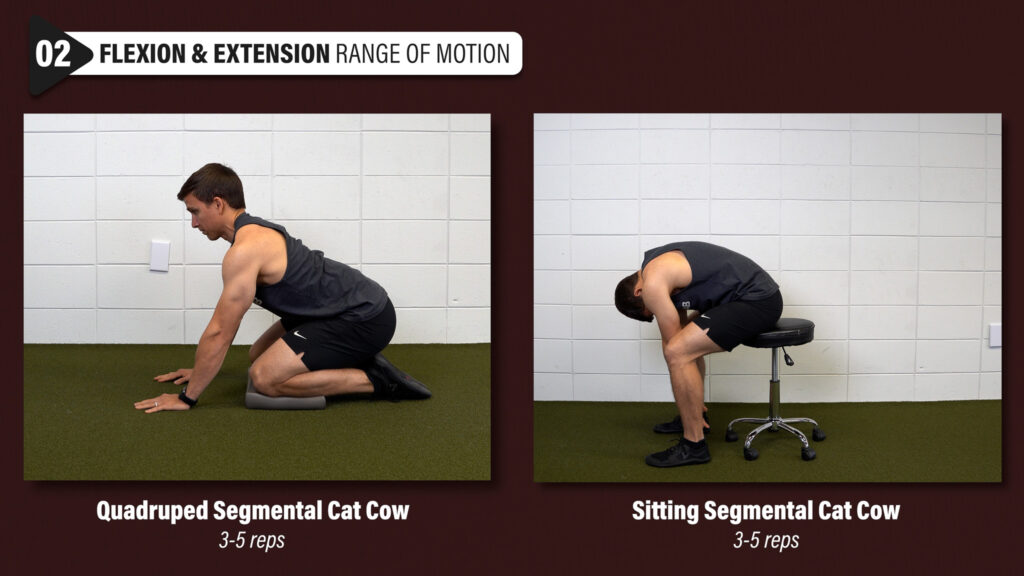
If you want something even simpler to do, you can do 2 to 3 neck circles in each direction in sitting or standing. Think about drawing as big of a circle as possible with your nose to explore the full range of motion of your neck.
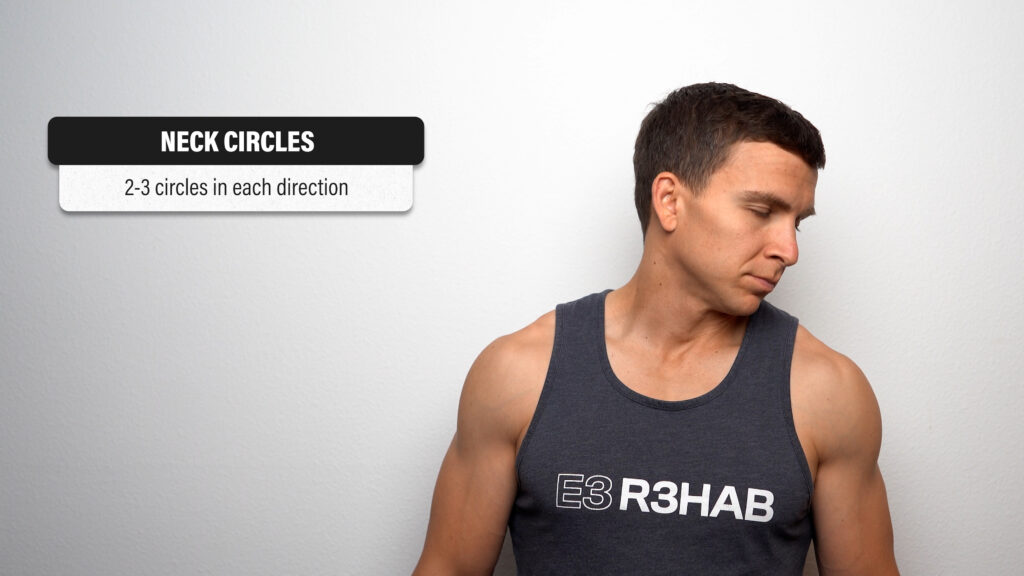
To make any of the movements easier or less intense, move slower and through a lesser range of motion.
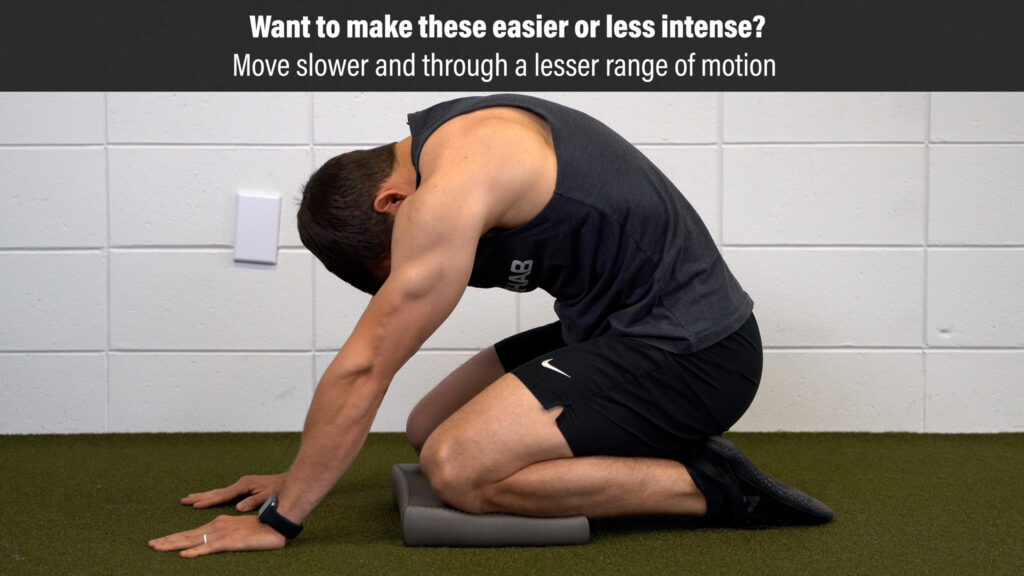
Strengthening Exercises
The next category of exercises relates to isolated strengthening of the neck. Isometrics, in which little to no movement occurs, can be a useful starting point.
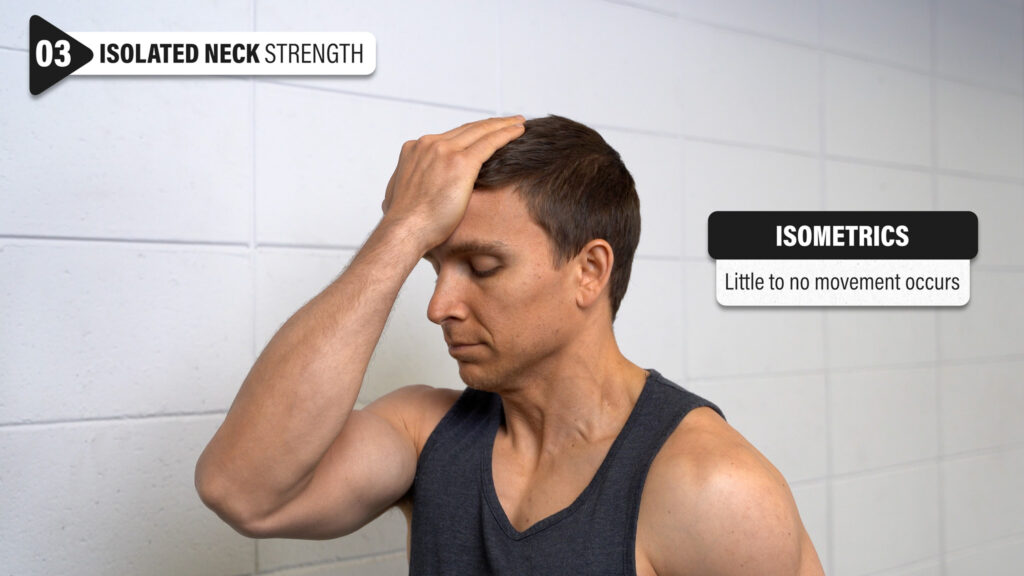
Option 1: Manual Resistance. You can use your hands to resist flexion or extension of your neck. If you put your hand on your forehead and stop yourself from looking down, you are resisting neck flexion. If you put your hand on the back of your head and stop yourself from looking up, you are resisting neck extension.
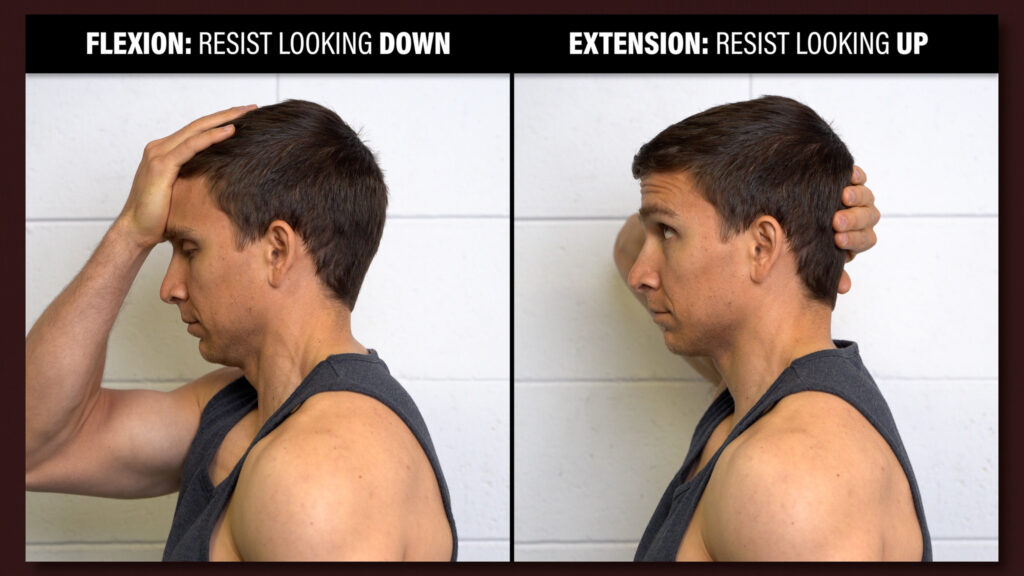
The goal is to find a tolerable starting point. If you resist as hard as you can, that’s 100%. Half of that is 50%. Half of that is 25%. You don’t need to go all out. Start with an estimated percentage that’s comfortable.

Option 2: Against A Wall. You can use a towel, pillow, foam pad, exercise ball, etc. For flexion, you’ll lean forward against a wall with a slight chin tuck. For extension, you’ll lean backward against a wall with a slight chin tuck.

The further you move away from the wall, the harder the exercise should be.

Option 3: On Your Back or All Fours. For flexion, you can lie on your back, tuck your chin, and lift your head high enough to slide a piece of paper underneath it.

For extension, you can set up on all fours, slightly push the ground away from you, and imagine pulling your head back from an awful smelling item.
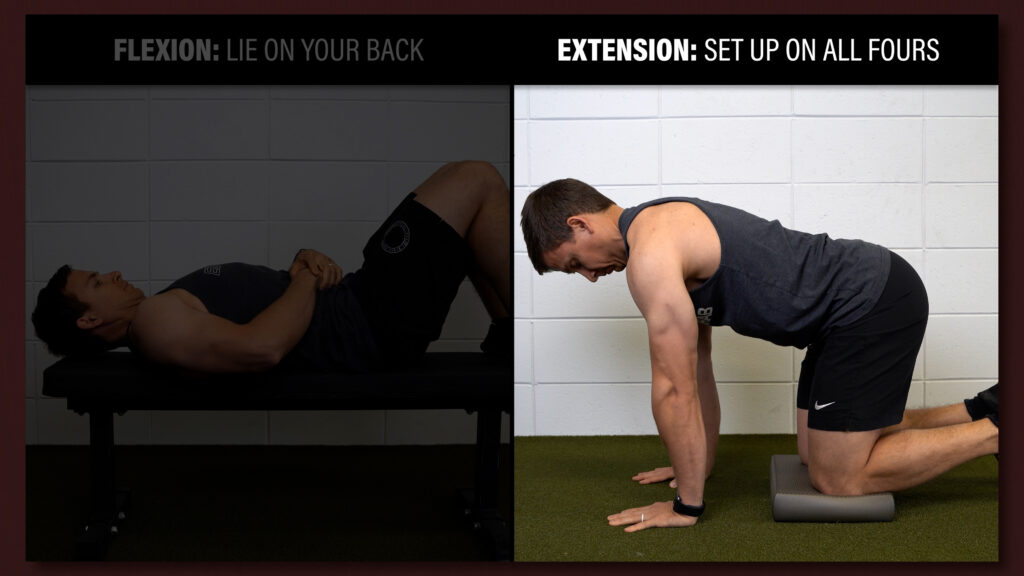
You can pick one of the three options and try to accumulate 60 seconds of work total, up to 3 times per day. You can do 1 set for 60 seconds, 2 sets for 30 seconds each, 6 sets for 10 seconds, etc. These can be done daily or every other day.

If you’re interested in integrating your shoulders and upper back as well, you can implement a 4-step strengthening progression on your stomach.
Level 1 – Prone A. While lying on your stomach with your elbows straight and hands by your side, slowly lift the front of your shoulders and hands off the ground before lowering back down. Your palms can be facing up or down.
To make the exercise easier, keep your hands in contact with the ground.
Level 2 – Prone T. Perform a similar movement with your arms out to your side so that you create a “T.” Your palms can be facing down or you can give a “thumbs up.”
Level 3 – Prone Y. The execution is the same except you’ll make a “Y” with your arms.
These exercises can also be performed on a bench or elevated surface. Aim for 2-4 sets of 10-15 repetitions.
Level 4 – Prone Angel. Start with your arms by your side, lift them off the ground, bring them overhead, and return to the starting position. Aim for 2-4 sets of 6-8 slow and controlled repetitions.

For all of the exercises, place a towel under your forehead for comfort. If you want to specifically make these movements more challenging for the neck, keep your head slightly lifted off the ground.
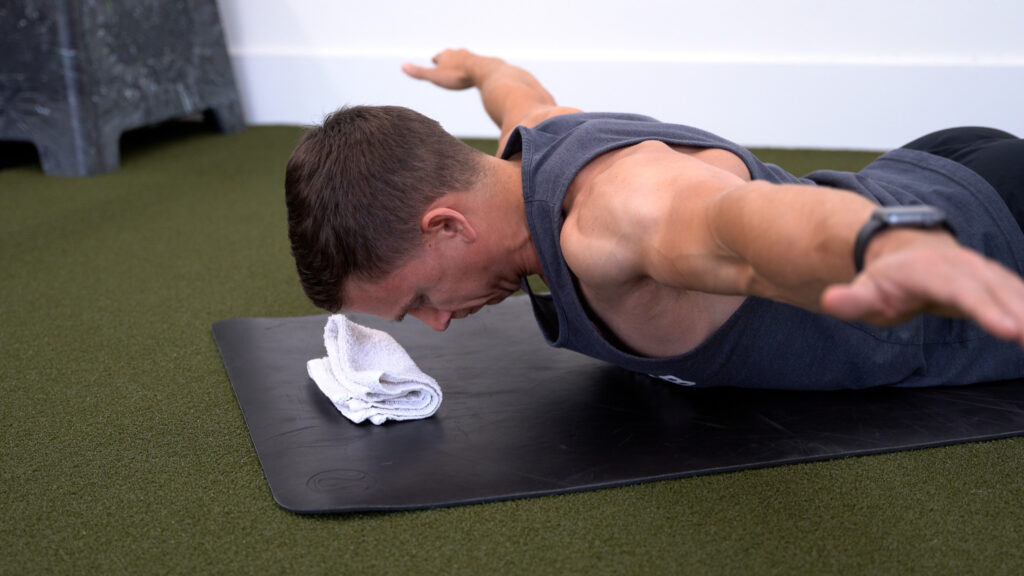
No Quick Fix or “Best” Exercise
Unfortunately, there is no quick fix or “best” exercise for whiplash-associated disorders. Up to 50% of individuals continue to report having neck pain 1 year after their initial injury, which is why it’s so important to focus on active, self-management strategies. For example, a systematic review by Christensen et al in 2022 reported that “In general, our findings favor an active or act-as-usual approach over standard treatment or immobilization using a soft-collar.”
Although the injury, or the symptoms associated with the injury, can be worrisome, it’s typically safe and encouraged to remain physically active. One way to help accomplish that is by implementing the exercises presented in this blog.
The range of motion and neck strengthening exercises can be incorporated into your daily routine as needed throughout the day.
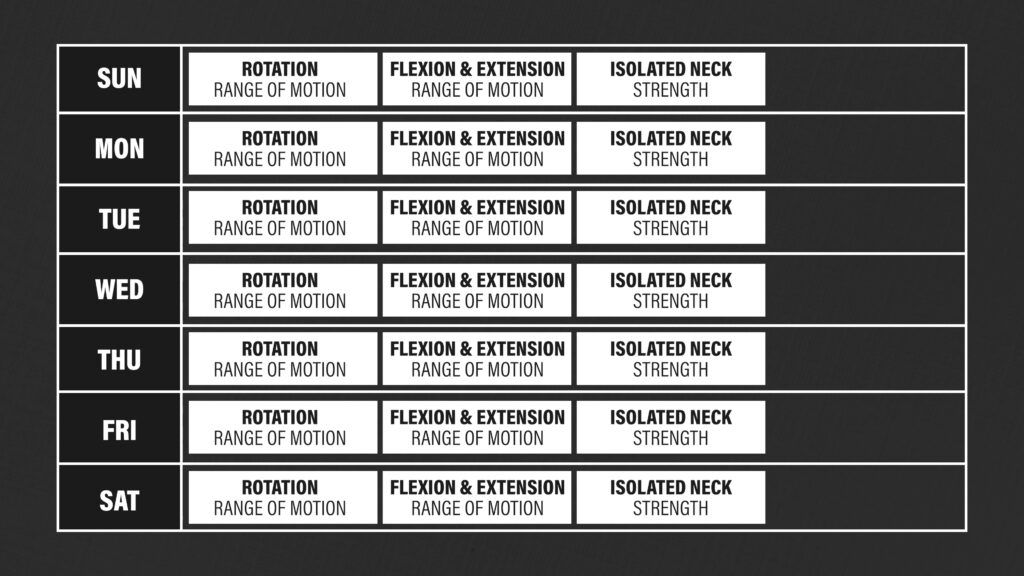
For example, you might perform the side lying rotation, seated cat cow, and manually resisted neck isometrics twice per day.
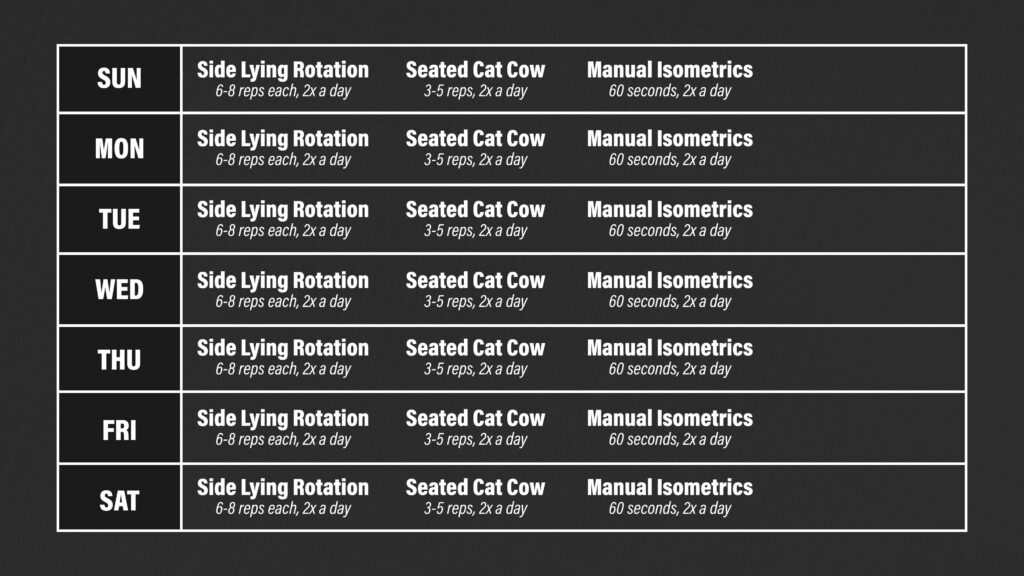
If you wanted to integrate strengthening of your shoulders and upper back, you could include the prone exercise progression every other day.

However, it’s helpful to understand that there’s nothing inherently special about any of these exercises. You could do any number of movements or activities, such as walking, swimming, or whatever else you might like. Your primary goal is to gradually improve your overall function, confidence, and tolerance, so you feel more in control of your situation.
Whiplash Injury Summary
In summary, whiplash injuries result from the rapid acceleration and deceleration of the head and neck, usually during a car accident. Whiplash-associated disorders (WAD) refer to the symptoms experienced after a whiplash injury, such as neck pain, dizziness, headaches, unsteadiness, fatigue, and even certain cognitive deficits.

In addition to 50% of people continuing to report neck pain 1 year after their initial incident, many find the injury life-changing due to difficulties with sleep, exhaustion from hypervigilance, anxiety, guilt, fearfulness, and a host of other feelings and emotions.

Here’s how one woman describes her experience:
“I want to do so much, or my brain wants to do things, but my body doesn’t get along with my mind. It’s hard for a person. I have pain; I have illness. I know that, but at the same time, it’s like it isn’t me. It’s hard to describe the odd feeling of not recognizing myself in the person who I am. I take painkillers and keep on going, but at the same time, my body is completely exhausted.”
Persistent symptoms and chronic disability are associated with lower self-efficacy, negative expectations of recovery, and passive coping strategies.

Therefore, the mainstay of rehab should be active, self-management strategies with an emphasis on finding ways to improve your control of your situation.
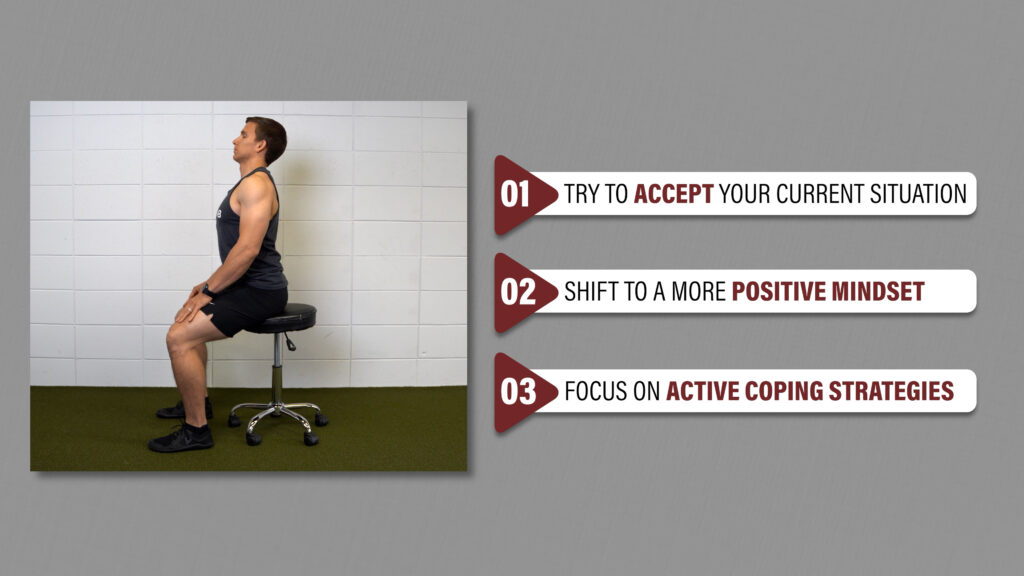
Don’t forget to check out our Neck & Thoracic Resilience Program!
Do you want to read other similar blogs? Check out these topics:
Rhomboid Pain Exercises, Rhomboid Pain, Cervical Radiculopathy
Thanks for reading. Check out the video and please leave any questions or comments below.


